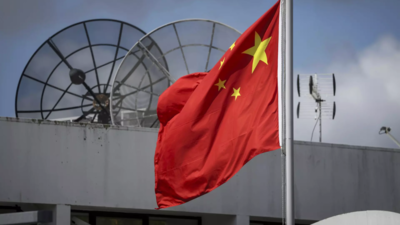- News
- World News
- China News
- 'No need for cell towers': China has revolutionised smartphone communications
Trending
'No need for cell towers': China has revolutionised smartphone communications
Chinese scientists achieve a groundbreaking milestone with the world's first satellite 'Tiantong' enabling direct smartphone calls. The Tiantong-1 series in geosynchronous orbit covers Asia-Pacific, supporting brands like Huawei, Xiaomi, Honor, and Oppo. Satellite calls crucial in emergencies like Gansu earthquake. China leads in satellite communication, bridging global communication gaps.

NEW DELHI: In a landmark achievement for satellite communications, Chinese scientists have developed the world's first satellite capable of enabling smartphone calls directly, without the need for ground-based infrastructure. Named "Tiantong," which translates to "connecting with heaven," the initiative draws inspiration from the biblical story of the Tower of Babel, aiming to bridge communication gaps rather than create them.
The Tiantong-1 satellite series, which began with its first launch on August 6, 2016, now includes three satellites in a geosynchronous orbit at 36,000km, covering the entire Asia-Pacific region.This breakthrough came to fruition when Huawei Technologies released the world’s first smartphone supporting satellite calls in September of the previous year, leading the way for other manufacturers like Xiaomi, Honor, and Oppo to follow suit, a South China Morning Post report said.
These technological advancements have proven invaluable, particularly in emergency situations where traditional communication networks are compromised. For instance, during the 6.2-magnitude earthquake in Gansu province on December 18, affected individuals could maintain contact with the outside world thanks to the satellite call function available on their smartphones.
“Direct satellite connectivity for mobile phones has become a new development trend, and satellite communication will gradually become popular among the general public,” noted a team led by Cui Wanzhao from the China Academy of Space Technology. Their work, detailed in the Aerospace Science and Technology journal, highlights the overcoming of significant technical challenges related to passive intermodulation (PIM), which can degrade the quality of satellite calls.
The idea for such a satellite came about after 2008, when Sichuan, a province in southwestern China, was struck by a devastating magnitude-8 earthquake, resulting in the tragic loss of over 80,000 lives.
What made the situation far worse back then was the communication breakdowns in affected areas, which in turn severely hindered rescue operations, thus compounding the crisis.
In response to this disaster, the Chinese government started the Tiantong Project, a satellite communication system. The purpose of the satellite is to provide universal access to communication services irrespective of socio-economic status.
China's advancements in this field are securing its position as a leader in satellite communication technology globally, heralding a new era where geographic isolation no longer equates to communication isolation.
The Tiantong-1 satellite series, which began with its first launch on August 6, 2016, now includes three satellites in a geosynchronous orbit at 36,000km, covering the entire Asia-Pacific region.This breakthrough came to fruition when Huawei Technologies released the world’s first smartphone supporting satellite calls in September of the previous year, leading the way for other manufacturers like Xiaomi, Honor, and Oppo to follow suit, a South China Morning Post report said.
These technological advancements have proven invaluable, particularly in emergency situations where traditional communication networks are compromised. For instance, during the 6.2-magnitude earthquake in Gansu province on December 18, affected individuals could maintain contact with the outside world thanks to the satellite call function available on their smartphones.
“Direct satellite connectivity for mobile phones has become a new development trend, and satellite communication will gradually become popular among the general public,” noted a team led by Cui Wanzhao from the China Academy of Space Technology. Their work, detailed in the Aerospace Science and Technology journal, highlights the overcoming of significant technical challenges related to passive intermodulation (PIM), which can degrade the quality of satellite calls.
By addressing the PIM issue, the team has enabled exceptionally sensitive reception capabilities in the Tiantong satellites, allowing them to pick up signals from standard smartphones without the need for external antennas. This capability is critical, especially given the satellites' exposure to extreme temperature variations and their operation across multiple frequency bands.
The idea for such a satellite came about after 2008, when Sichuan, a province in southwestern China, was struck by a devastating magnitude-8 earthquake, resulting in the tragic loss of over 80,000 lives.
What made the situation far worse back then was the communication breakdowns in affected areas, which in turn severely hindered rescue operations, thus compounding the crisis.
In response to this disaster, the Chinese government started the Tiantong Project, a satellite communication system. The purpose of the satellite is to provide universal access to communication services irrespective of socio-economic status.
China's advancements in this field are securing its position as a leader in satellite communication technology globally, heralding a new era where geographic isolation no longer equates to communication isolation.
End of Article
FOLLOW US ON SOCIAL MEDIA











